INTRO:
Nowadays, it is not often that one would find a game where the player character is a flotilla of vehicles from an offworld group looking to leave a post-apocalyptic world.
It is even rarer to find a game where the player does all that while being subjected to a rogue-lite experience, in addition to controlling not one, but multiple vehicles in a lane-based combat encounter a la Spy Hunter.
Yet, comparing it to old classics like Spy Hunter would have been an underestimation of how much more sophisticated that Convoy’s gameplay is over the arcade classic. Comparing it to rogue-lite indie titles like Faster Than Light is not that appropriate either, because the game does not resort to cheap luck-dependent gameplay to stretch the experience.
Considering how different Convoy seemed at the time, it would be no surprise to jaded game consumers that its Kickstarter-funding had been successful in 2014.
More than a year later, and sometime after its launch, it can be seen that it meets some of the expectations for it, while being halfway-there about the rest.
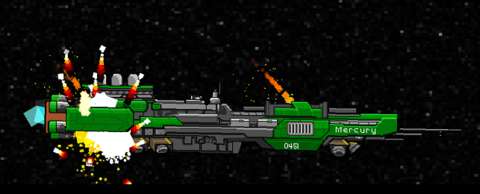
PREMISE:
The player character is part of the crew on board a space-ship on a yet-undisclosed mission. After suffering the effects of a certain space anomaly, the ship has to make an emergency landing on the backwater planet of Omek Prime. The ship is in need of repairs, and these repairs require the retrieval of critical parts for the ship. Fortunately, the ship’s crew has some good ideas on how to find them on Omek Prime, which so happens to be not exactly technologically backwards.
Unfortunately, getting the parts is easier said than done. Omek Prime is inhabited by three warring factions, all of whom do not take well to off-world visitors. Getting the parts is likely to entail considerable violence, and the space-ship parts are expected to be quite big.
Therefore, there has to be a convoy of rugged vehicles which will have to traipse through the surface of Omek Prime to find the parts and ferry them back to the ship. It so happens that the player is the commander of the titular convoy.
TECHNICAL ISSUES:
One would think that a game that looks like Convoy should not have any technical problems, but there are (or were, if they have been fixed when you, the reader, are reading this). Unfortunately, they are among the first things that the player encounters.
The first of these is the “pixel perfect” option. On some computers, it appears to cause the game to stutter, especially when text appears on-screen. Disabling it solves the stuttering, but causes text to lose their sharpness. The text is still visible, but it is not as easy to read as when “pixel perfect’ is turned on.
Another problem is the curiously long loading time when the game application is launched. However, this might be a bit understandable, because there are more sprites and artwork than one would think would be in this game. Yet, the loading could have been more efficient, if one compares this game to other indie games which use sprites and other 2D visual assets.
GAMEPLAY – OVERVIEW:
The gameplay in Convoy can be split into two portions, either of which is very different from the other. It is also worth noting here that one portion is more luck-dependent than the other, whereas the other consistently rewards good skill such that luck is a minor factor, if at all.
The luck-dependent portion occurs when the player’s convoy is moving across the surface of Omek Prime. The key effect of luck in this portion is the pervasiveness of random encounters that can happen at any time without any warning. Other luck-dependent gameplay elements include the seemingly random placement of scenario locations, and even the seemingly random seeding of scenarios at these locations.
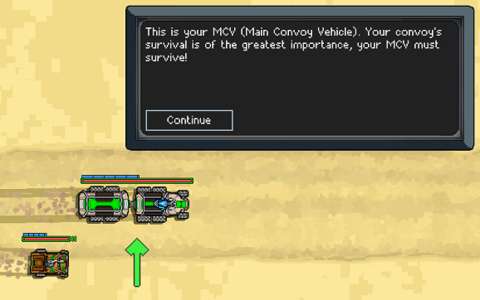
There are other frustratingly luck-dependent gameplay elements in this segment of the game, as will be described later.
The skill-rewarding portion of the gameplay is, fortunately, the one which matters more in the player’s experience of Convoy. There will be a lot of combat in the game, so it is fortunate that this part of the gameplay is more within the control of the player than the other one.
Anyway, combat is observed via a side-scrolling, top-down view, through which the player determines the positioning of his/her vehicles for (hopefully) maximum effect.
This portion of the game is easily the more sophisticated and more rewarding of the two, as will be described later.
TOP-DOWN VIEW FOR COMBAT:
Even though it might not seem like it, the top-down view which is used for combat is one of the most important aspects of the game. This is because the game will remember the positions of the convoy’s escort vehicles – relative to the MCV – from one combat encounter to the next.
When the player continues a saved game, the player will be given the top-down view of the convoy, which is exactly the same as the one which is used for combat. During this occasion, the player will not make any progress across the world map, but he/she can use this opportunity to rearrange the convoy’s escorts.
Incidentally, in this occasion, the convoy is placed into what appears to be an empty desert with a road. (This is actually one of the terrain types in the game, which will be described later.) It will be uneventful, so the player can rearrange the convoy’s formation without any problem.
However, after the player opens the world map, he/she will not be able to return to this view, at least not until the next combat encounter (which is usually not a good time to rearrange the convoy’s formation). The player will have to save and exit the game, and then continue the saved game in order to bring up the top-down view again.
It is unfortunate that the developers of the game had not thought of the need for a more user-friendly feature that allows the player to rearrange the convoy outside of combat.
MAP - OVERVIEW:
The map screen is where much of the luck-dependent parts of the gameplay occurs.
The game may not exactly take place across the entirety of Omek Prime. Rather, it appears to take place across a region; to players who know a thing or two about topographical maps, it may seem no larger than a state in the USA. Still, there is enough content in between any two corners for a playthrough of several hours, assuming that the player is skillful enough to last this long. Furthermore, not all of the content in the game can be found in a single playthrough.
Moving about the map is as simple as clicking at one point to have the convoy move over to there. Yet, it is rare for a trip between two points to be uneventful. If the player would move from one corner of the map to another; there will be countless combat encounters in between, stretches of terrain which stall movement (more on these shortly) and, amusingly, a lot of distractions in the form of yellow icons that are difficult to ignore.
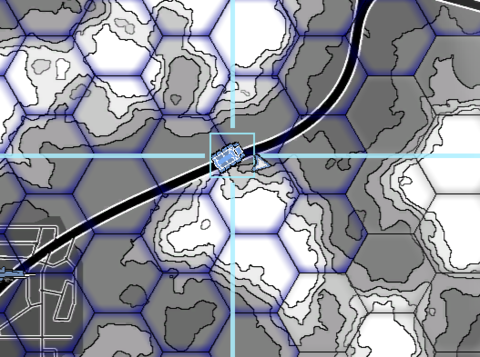
It should be stated here that the map and the places in it are fixed from playthrough to playthrough. For example, the player’s ship – and home base – will always be somewhere around the middle of the map. The only differences from playthrough to playthrough are the placement of the icons which represent the scenarios that the player would participate in. (There will be more on scenarios later.)
The specific gameplay elements – and problems – which are associated with the map will be described shortly.
PROBLEMS WITH MAP SCREEN:
Unfortunately, there are problems with the map screen. One of these might be obvious almost immediately: the player cannot scroll the map around.
Considering that the player has technically been provided with the map of the region of Omek Prime which the convoy would travel around in, that the map cannot be scrolled around is an unacceptable limitation.
(There can be the argument that the convoy has limited radar or sensor ranges, but if the convoy does have radar or sensors, these do nothing to warn the player about random combat encounters.)
Furthermore, the player cannot view the map in its entirety too. It would have helped the player plan his/her course; if the player wants to do this, he/she will have to resort to looking at a map of Omek Prime outside of the game.
TERRAIN:
An important factor to keep in mind when travelling across Omek Prime is terrain. Although Omek Prime appears to be mostly desert or wasteland, there are still a few different kinds of terrain to look out for.
Chief of these are terrain elevations. The map happens to show these; the brighter shades of gray and white show higher elevations. Higher elevations are slower to travel through, so it is in the player’s interest to avoid them wherever prudent.
Elevations do not appear to affect the speed of combat, though higher elevations do seem to increase the density of oncoming rock obstacles during combat. (There will be more elaboration on oncoming obstacles later.)
Next, there are roads. These are what the convoy should remain on, because roads make travelling fuel-efficient and a lot faster. Roads also pose the least amount of oncoming obstacles in combat encounters. However, the road network on Omek Prime is not very extensive, so there will be occasions when the player will have to go offroad.
Finally, there are cities, or, more likely, ruins of cities. These offer movement that is as easy as that of roads, but combat encounters which occur in them are likely to have a significant number of oncoming obstacles in the form of buildings.
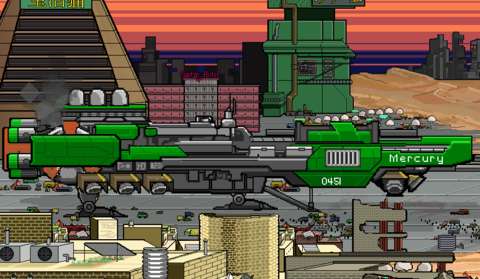
FACTIONAL TERRITORY:
Omek Prime is not an uninhabited world, but the inhabitants are not always friendly to off-worlders. They generally belong to one of three factions: the T.O.R.V.A.K., the Privateers and the Raiders.
The game does provide some backstory for these factions, but gameplay-wise, they mainly serve to determine the general composition of enemies which the player would face in random combat encounters.
As for the general composition of enemies which the player would face, this will be described further later. However, it should be mentioned here that the density of the presence of a faction in any part of the map is depicted by the strength of the tint of the colour which is applied on that part of the map, the colour being associated with the faction.
(Speaking of the colours used, they are of hues which are quite far from each other on the spectrum of visible light. It may not address every variant of colour blindness of course.)
Anyway, the strength of the tint determines the capability of the enemies which the player would have to oppose in random combat encounters, wherever these occur. Stronger tints mean that the player will be facing more numerous and more well-equipped enemies, which is, of course, a worse situation.
More importantly, the factional tints will inexorably spread and strengthen over time. The most basic factor that controls the rate of this is how long the player’s convoy had been travelling around on Omek Prime, but other factors such as how many ship parts that the player has obtained and how many battles which the player has won will accelerate this growth.
Unfortunately, this is about as much as the player can expect from the gameplay element of factions. There does not appear to be any further complexity to be had from it, such as currying favour with the factions or playing one against another.
(There are scenarios which are associated with specific factions, but these scenarios act as little more than side quests. The factions do not appear to remember what the player has done for them – or against them – in these scenarios.)
RANDOM EVENTS - FOREWORD:
As the player travels around Omek Prime, the convoy will either come under attack or come across peculiar scenes.
In the case of the former, the player will be immediately shunted into combat, though the convoy’s vehicle might suffer some damage before combat starts, if the player is unlucky enough to suffer particularly nasty combat encounters.
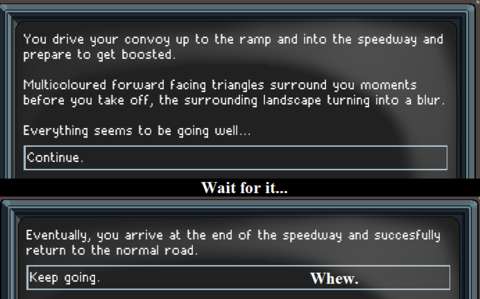
In the case of the latter, the peculiar scenes may be a prelude to yet another combat encounter, though again, this depends on the player’s luck. For example, the player might come across another convoy, which may or may not be hostile. The player is usually given two mutually exclusive options to pick from, e.g. attempt to evade the enemy or meet it head-on in the case of hostile convoys, or attempt to hail them or attack them outright.
The options do suggest what the player can expect if they happen to turn out as expected. For example, if the player is lucky, an attempt at evasion or disengagement might work and the player’s convoy would get away.
Unfortunately, the actual outcome which the player would get is dependent on an RNG roll. Returning to the example of the evasion attempt, the player’s convoy might be spotted anyway, and combat would ensue. Yet another example is a failure at disengagement, upon which the player would be forced into combat, on top of any fuel that might have been lost in the escape attempt.
Some of these random events are not combat encounters at all. These non-violent scenes usually pose a seeming opportunity for the player to save some fuel (more on fuel later), salvage some screws or even obtain a trade. Unfortunately, bad luck can turn an opportunity into a spate of misfortune.
The worst of these bad-luck outcomes are the ones which inflict damage outright on the vehicles in the player’s convoy. For example, the player might come across a weapons cache and attempt to loot it, only to have it explode.
Unlike a certain other rogue-lite game, Faster Than Light, there does not seem to be any way to guarantee successful outcomes from random events by utilizing the equipment which the convoy has. For example, an attempt at disengagement could have been successful if there is an option to make use of any mine-layers which have been mounted on the MCV, but there is no such option.
RANDOMIZED REWARDS FROM RANDOM COMBAT ENCOUNTERS:
After winning a random combat encounter, the player is rewarded with some loot, presumably salvaged from the wrecks of enemy vehicles. However, the rewards can vary wildly, despite the presence of scaling factors for them.
The extent of the range of the rewards appears to be proportional to the severity of random combat encounters. However, the exact magnitude of the reward is not for certain; the game will make RNG rolls within the aforementioned range.
Therefore, getting rewards for beating combat encounters is not a matter of risk-versus-reward, but rather one of luck. For one, the player might suffer the bad luck of having pulled through a tough combat encounter, only to be screwed over by being “rewarded” with just a few screws. Of course, there can be occurrences of good luck as well, but then, this would mean that the player’s windfall was due to good luck and not his/her skill.
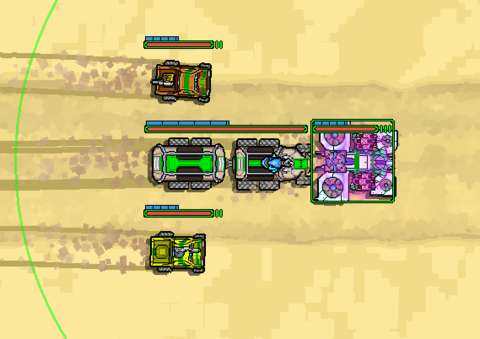
SCENARIO LOCATIONS:
There are points of interest in the map which are depicted by icons which are composed of yellow concentric hexagons. These will appear on the map as the playthrough progresses, and will generally stay where they are until the player comes across them and handle whatever they will throw at the player.
If the player’s convoy approaches these locations, the game will randomly draw one scenario from the range of scenarios which are (loosely) applicable to the circumstances at the time. For example, one of the significant circumstantial factors is the faction which controls the region that this location is in. The game will consequently pick scenarios which are associated with the faction.
This means that the player can attempt to exploit this gameplay element by milling about while waiting for scenario locations to appear in the territory of a specific faction, if only to try to exhaust the list of scenarios which is associated with the faction. It is risky though, because of the inexorable growth of the strength of the factions, as mentioned earlier.
Some scenarios are particularly notable because of the rewards which the player could possibly obtain. Among these, the scenarios which grant vehicles as reward options are the most coveted, because they are some of the very few ways to obtain additional vehicles. There are also scenarios which pose special combat encounters, which will be described later.
In addition to the yellow concentric hexagons, there may also be additional details in the icons. These are usually used to denote their importance to any quest which the player is pursuing. For example, an exclamation symbol generally mean that a scenario location is the place where the next step for a quest can happen.
Unfortunately, the usefulness of this convenience does not compensate for the fact that the player cannot view the map of Omek Prime in full at any time. It would have been easier to find quest-specific scenario locations if the player could do so.
CAMPS ON MAPS:
Camps are special locations on the map which the player can visit in order to purchase fuel and trade equipment in return for screws. These will also be the places which the player needs to go to in order to restore the convoy’s combat capabilities.
The locations of camps appear to be randomized from one playthrough to the next, though their exact positions will be procedurally generated such that almost every region of the map has at least one camp. The only constant is the grounded space-ship, which also acts as a camp, though it lacks any equipment for trade.
Even so, the distance between camps is still considerable enough to pose a worry; even if the player is skillful at dealing with combat encounters, attrition will always be a problem due to a lack of a sustainable way to keep vehicles in the convoy repaired aside from the services of camps. Fortunately, the game does have a convenient feature which informs the player of the general direction of the nearest camp. Yet, again, the inability to see the full map prevents the planning of routes around the map such that the player’s path will be conveniently close to camps.
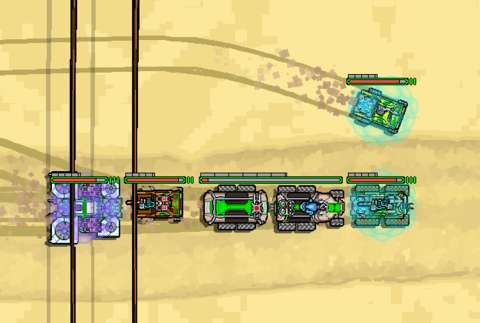
There will be more statements on camps later when other gameplay elements which are related to them are described.
FUEL:
Fuel is a resource that is important for the convoy’s travels. If the convoy runs out of fuel, it will be stranded where it is. The player will forced to spend time cycles on waiting for a random event to happen, and even when this happens, he/she will have to hope to be able to scrape enough fuel from its outcome such that they can reach a more reliable source of fuel, namely a camp.
Obviously, it is the player’s interest to make sure that this does not happen. Fortunately, any camp has unlimited reserves of fuel to sell, oddly enough; after all, there does not appear to be any industry on Omek Prime which suggests that fuel can be easily produced.
VEHICLES – OVERVIEW:
Interestingly, the player will never see a human in-game, discounting the specks that move about in the main menu. The player will be seeing a lot of vehicles, however – heavily-armed vehicles.
Obviously, vehicles only appear in the combat screen. They move along the “lanes” which make up the screen, though the MCV is always on the center lane. The others can move about freely, but do so at different speeds and with different inertia.
Although Spy Hunter has been mentioned in this review, the vehicles in this game do not fire their ordnance along the lanes which they are travelling on, like the vehicles in the classic title do. Instead, all of their weapons are mounted on turrets which have full 360-degree arcs of rotation. The turrets on the MCV rotate the slowest; the turrets on every other vehicle appear to rotate faster, and at the same rate as each other, regardless of the weapon which is mounted.
All vehicles have hit points and armor meters. Obviously, when they run of hit points, they blow up and they are gone for good. As for armor, it acts a lot like the armor in old first-person shooter games of yore; it absorbs incoming damage that would have been applied on hit points instead on a percentage basis. However, armor also happens to be chipped away by any incoming attack from any weapon, even if the description of a weapon suggests that it “does nothing” against armor (such as the pulse lasers).
All vehicles are armed. Although their weapons have statistics such as fire rate and damage per second ratings against health and armor, ammunition is not an issue; any weapon can be fired over and over indefinitely. Furthermore, the amount of fuel which the convoy has does not appear to affect the performance of vehicles; the vehicles do not consume fuel in battle either.
These might appear as unseemly simplifications, but they do allow the player to focus on the positioning of vehicles. Nevertheless, there are a lot of wasted opportunities to make combat more complex, such as including options to expend fuel to increase the speed of vehicles.
There are more nuances and problems concerning vehicles, which will be described further in their own sections.
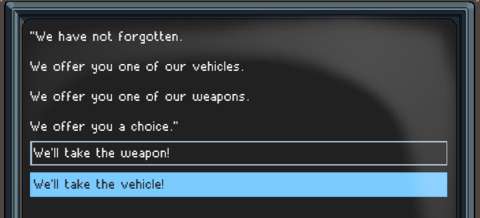
MCV – MAIN DESIGNS:
The MCV is the convoy’s main vehicle. If it is destroyed, it is a straight game-over for the player. Furthermore, most computer-controlled opponents are very likely to shoot at the MCV instead of the other vehicles in the convoy; after all, it is a large target which is a lot easier to hit than the other vehicles in the convoy.
Yet, the MCV is also the toughest vehicle in the convoy, with the highest amount of hitpoints and armor. Even the most tank-like escorts cannot have as many.
Moreover, the MCV does not lack offensive capabilities. There are “super-heavy” weapons which can only be mounted on the MCV, though these operate on cooldown timers instead of firing rates. These will be described shortly.
MCV-MOUNTED EQUIPMENT:
As mentioned already, there are weapons that can only be mounted on the MCV and they have cooldown timers instead of firing rates. They have to be manually directed to fire and will not track individual targets.
These limitations are intended to counter-balance against the strength of these weapons, which is their considerable damage output, in the case of “super-heavy” variants of weapons, or their tactical versatility, in the case of “utility” gear such as EMP guns and Repair drones.
“Super-heavy” weapons have to be manually directed, thus requiring the player to spend time and effort to control them instead of issuing further orders to the escort vehicles. The player can attempt to use the pause feature to attempt to do both, of course, but to obtain the most damage output from the super-heavy weapons, the player will need to anticipate and lead enemy vehicles (who are likely to try to get out of the way), which is best done via manual control. Nevertheless, the damage potential is worth the opportunity cost.
“Utility” gear may not directly damage enemies, but some of them are useful enough to remain so even in the late stages of a playthrough. Chief of these are the aforementioned EMP guns and Repair drones.
In addition to temporarily disabling the weapons of an enemy vehicle, an EMP attack also happens to drop its shields immediately, making it particularly handy against T.O.R.V.A.K. and Privateer vehicles.
Drones are machines that can be set to target vehicles, wherever they are. It will take a while for them to reach their targets, but there does not seem to be any way for the drones to lose their targets.
(Despite the statement that drones are equipment which is mounted on the MCV, there are enemy vehicles which do use drones, despite not being as massive as the MCV. These enemies are rare, however, and are generally fought against in combat-oriented scenarios instead of random combat encounters.)
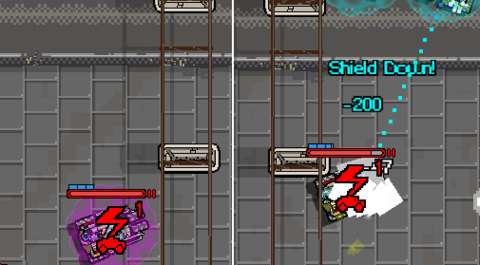
Interestingly, the Repair Drone takes hitpoints from the MCV and transfers them to escort vehicles on a one-to-one basis. This makes the Repair Drone difficult to exploit in order to reduce the need for repairs at camps. The player could pair the Repair Drone with a Leech Drone, which takes hitpoints away from enemies and give them to the MCV, but this of course takes away slots which could have been used for other MCV-mounted equipment.
Speaking of which, the MCV may be a massive vehicle, but there can only be so much space for equipment. Therefore, the player will need to consider his/her choices carefully.
MCV CARGO HOLD:
The MCV can also carry un-mounted equipment around, but only a handful. This is not unlike the limited space in the cargo hold of the player’s ship in Faster Than Light.
However, unlike the cargo hold of the ship in this other indie game, the un-mounted equipment cannot be re-mounted and de-mounted at any time outside of combat; mounting and de-mounting can only be done at camps. This means that the MCV’s cargo hold is useful for nothing more than to keep loot until the convoy reaches the next camp.
(It should be mentioned here that the cargo space which is used to carry ship parts are not the same as the space which is used to carry un-mounted equipment.)
ESCORT VEHICLES – MAIN DESIGNS:
As the game would emphasize, the MCV is there to carry parts back to the space-ship; it is not entirely capable of defending itself. For this purpose, there are more mobile vehicles that would follow the MCV around.
They can range from buggies and four-wheel drives to tanks and APCs, or even hovercraft if the player is lucky. All of them can keep up with the MCV, or at least the game gives the illusion of such an impression.
All types of vehicles have at least one weapon slot, so each vehicle can be armed with something. However, certain vehicles have more than one weapon slot, and some others have utility slots as well for defensive and/or tactical equipment. There will be more elaboration on this hardware later.
The player always starts with two escort vehicles, but can obtain up to two more, or even replace the starting ones with others. To do so, the player will need to seek out opportunities to obtain vehicles, but these are exceedingly rare.
There is at least one camp which will sell a vehicle, but it can take a while to find where this camp is. Even then, the vehicle which is sold is randomly chosen from the generic models, and it may not be the one which the player wants.
MODELS OF ESCORT VEHICLES:
There are slightly more than a dozen generic models of escort vehicles. These are considered “generic”, mainly because they are not unique one-of-a-kind vehicles. The player could possibly obtain more than one vehicle of any generic model.
The main differences between these models are their performance ratings, the numbers of utility and weapon slots which they have and their upgrade options (more on these later).
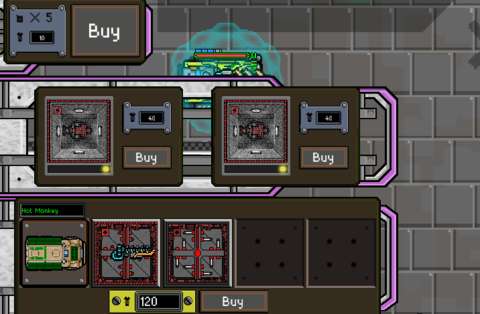
There are some models, such as the Bobcat series, which start out seemingly weaker than others, at least in their un-upgraded state. These do become more competitive if the player invests in upgrades in them, but the player might also want to weigh the opportunity costs of spending screws on upgrades against the costs of simply replacing these vehicles with the ones which start out better.
UNIQUE ESCORT VEHICLES:
There are a few unique vehicles which can only be obtained through certain scenarios and sheer luck. These vehicles have few upgrade options, but out-perform un-upgraded generic vehicles by a big margin.
For example, the “Gold Car” is a vehicle which can only be obtained by winning it from playing the Wheel of Fortune in the Lucky Peacock Casino, which is a drawn-out special event which occurs at a certain scenario location. The Gold Car has commendable statistics, but only one weapon slot.
Most of these vehicles are intended to be popular-culture references or tributes, albeit with more gameplay-related substance than most of the other references in the game. For example, the “Flower Car” is the occasional reward for showing respect to in-game memorials of the late Terry Pratchett.
VEHICLE STATISTICS & UPGRADES:
The performance of vehicles is expressed by a set of statistics. Among these, hitpoints (called ‘hull’ in-game) are the most important; once these hit zero, a vehicle will explode and turn into a wreck. Most vehicles allow the player to upgrade their hitpoint reserves, though not all of them do.
Obviously, in the case of the MCV, its hitpoints are its most important statistic. Many enemies will shoot at the MCV instead of its escorts, so it is in the player’s interest to consider upgrading the MCV’s hitpoints to their highest potential as soon as possible. This will also give the player a considerable reserve of hitpoints to use on Repair Drones.
Another important statistic is “range”. This is of course how far a vehicle can be from its target to hit it; it is conveniently depicted with a green circle, the colour of which happens to stand out from most things which the player can see during combat.
The range of any weapon is not dependent on the weapon, but rather the targeting system of the vehicle which the weapon is mounted on. Combat is mainly about positioning and one aspect of positioning is taking into consideration the distance at which a vehicle can hit its target, so range is likely to be one of a wise player’s upgrade priorities.
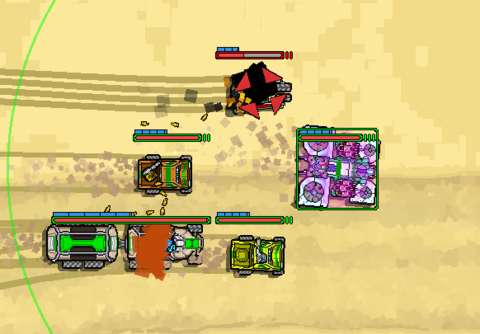
Another important statistic is handling. This determines the mobility of a vehicle. Getting a vehicle to where it is needed most will be integral to any strategy, so the player might want to prioritize upgrades for handling too.
For better or worse, the handling statistic is also used as a factor for a luck-dependent gameplay element, which will be described later.
The least important, but not entirely ignorable, statistic is “mine guard”. As its name suggests, it is a statistic that determines that how resistant a vehicle is to mines and collisions with wreckages. There will be more elaboration on mines and wreckages later.
“EVADE” RATING:
Every vehicle, including even the MCV, has a chance of evading incoming shots. This is a luck-dependent occurrence. However, due to an equation which is used to derive evasion percentages from the handling statistic, vehicles generally have very low evasion ratings unless they are specifically models which are designed for mobility. (The minimum evasion chance is 5%, by the way.)
The apparent evasion rating which a vehicle has comes into effect when it is not “moving”, i.e. not appear to be moving relative to the MCV. (This also means that the MCV will always ever have its evasion rating at its apparent level and never any higher.)
However, if the vehicle appears to be moving relative to the MCV, its evasion rating becomes considerably higher. Exactly how much the increase is would be a matter that is not known to the player, unfortunately. Yet, an astute player would observe that a moving vehicle is much harder to hit than a relatively stationary one. In the case of targeting enemies, the player would be wise to hold fire until they have settled on their positions.
WEAPONS:
The weapons which can be mounted on escort vehicles come in a considerable variety, though players who are experienced in combat-oriented games with sci-fi settings will be quite familiar with their gameplay designs.
There are bullet-shooting weaponry, starting with the Light Machinegun (which becomes obsolete very quickly) and increasing in caliber up to the 100-mm cannon, which is decently effective against hull, armor and shields (more on shields later). As mentioned earlier, ammunition is not an issue, so bullet-shooting weapons are not that much different from the others. At most, their differences are mainly in their statistics.
Then, there are plasma guns and pulse lasers. The former are intended to be used against armor and are not effective against unarmored hulls, whereas the former are intended to be used against unarmored targets but are completely blocked by armor. Theoretically, the player could load out vehicles such that they have both, or in the case of vehicles with just one weapon slot, pair up vehicles with these weapons.
In practice, it is perhaps more practical to have weapons that can damage both armor and hull so that the damage that is inflicted is not substantially wasted when the target runs out of anything that the weapon is effective against.
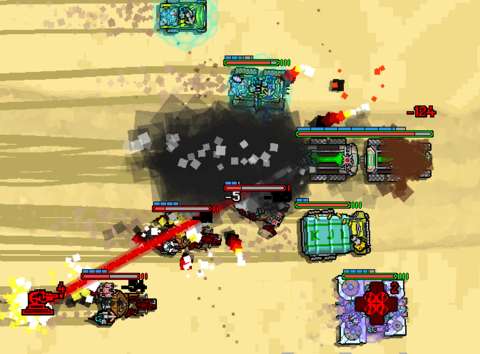
Railguns are the only weapons which are capable of punching through shields. Furthermore, they have high damage per shot, making them useful for making the first shots against enemies. However, they have very slow firing rates; considering the aforementioned gameplay element of evasion, it can be costly to miss even a single shot. Still, being able to punch through shields can make some battles (especially the very last) a lot shorter.
Missile launchers are powerful, if a bit inaccurate and having rather slow rates of fire. Their setbacks alone can put off players who prefer weapons with more reliable and steadier damage output. However, missiles are the only weapons which can shoot past and over vehicles which are in between the shooter and the target.
Beam lasers are perhaps the most reliable weapons to use. Despite what their names suggest, these are the laser-equivalents of machineguns. Each beam laser shot may not do much damage, but a beam laser gun can fire an incredible number of shots, and with virtually perfect accuracy too. (There will be more elaboration on accuracy later.)
WEAPONS FROM NEWLY OBTAINED VEHICLES & CAMPS:
Any vehicles which the player obtains after the start of a playthrough will have randomized weapons, unless the player is given the option to pick them. However, there is still a degree of certainty in the kinds of weapons which will be obtained; the caliber of the weapons will depend on how far the player has progressed in the playthrough, e.g. how many parts have been returned to the ship and how pervasive the factions have been become.
The weapons which are sold by a camp that the player has not reached will have their caliber generated according to progress of the playthrough. However, the camps will not update their inventory anymore afterwards.
ACCURACY:
Accuracy is a gameplay element that works against evasion. With high enough accuracy, a vehicle can overcome even the default minimum of 5% evasion that every other vehicle has, meaning that it will always hit its target. However, accuracy is not a statistic which a vehicle has. Rather, additional accuracy has to come from utility gear such as the targeting computer.
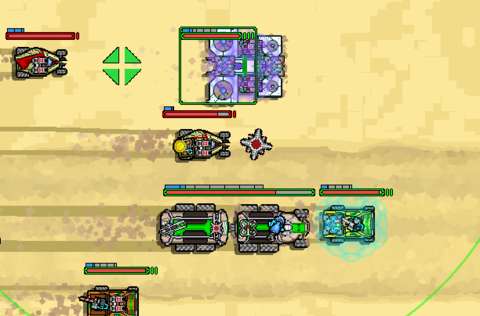
Accuracy is mainly determined by the weapon which a vehicle is using. For example, missiles have the poorest accuracy of all weapons; they are only capable of hitting relatively stationary targets. A vehicle that is moving suffers a hit to its accuracy.
The only weapon that can reliably hit any target is the beam laser, specifically the beam laser that is mounted on escort vehicles. (The MCV variant is something else entirely.)
RAMMING:
It would be difficult to miss the influence of Mad Max in the designs of this game. If the player has not noticed this until then, there is the gameplay element of ramming which will certainly give this impression.
A vehicle can ram another vehicle in order to inflict damage on both; the vehicle which is being rammed takes a bit more damage.
However, the main reason to ram a vehicle is to displace it. This can happen if the ramming vehicle is of a weight tier higher than the vehicle being rammed; the weight tier of a vehicle is depicted by the bar(s) next to the hitpoint meter of the vehicle. This will be handy for forcing a lighter enemy vehicle into mines and obstacles.
Other than that, there is no other viable benefit from ramming. The player could deck out a vehicle with the A.I.D. utility device and a chainsaw or buzz-saw to make it more effective at ramming, but using this vehicle requires a lot of micromanagement, with little pay-off in return for all that hassle. After all, ramming, even with chainsaws and buzz-saws equipped, cannot produce damage outputs that are as comparable with those from guns.
It is also worth mentioning that computer-controlled opponents do not appear to resort to ramming often, if at all. This gives the impression that ramming is a gameplay element which has been implemented as an afterthought.
UTILITY GEAR:
Some vehicles have slots for so-called “utility” equipment; slots for this are colored yellow instead of red. There are not as many utility devices as there are weapons though. Some have been mentioned already, such as the ballistics targeting computer and the A.I.D.
There are some others, which include the taunter, which is a “fierce” device (to use the game’s own words) that entices enemies to shoot at the vehicle which has the Taunter.
SHIELDS:
Of all the utility devices, shields are perhaps the most useful. Shields are essentially another layer of hitpoints, which are consumed first before actual hitpoints when a shielded vehicle takes damage. Shields can recover automatically, if the vehicle can stay away from incoming fire for a while. Shields can be immediately dropped with EMP attacks, however, which is something that the player might want to keep in mind.
WRECKAGE & MINES:
When a vehicle is destroyed, it turns into wreckage. This is not just for cosmetics; another vehicle can hit the wreckage and get damaged. The wreckage has essentially turned into a makeshift mine, albeit one that is not as powerful as actual mines.
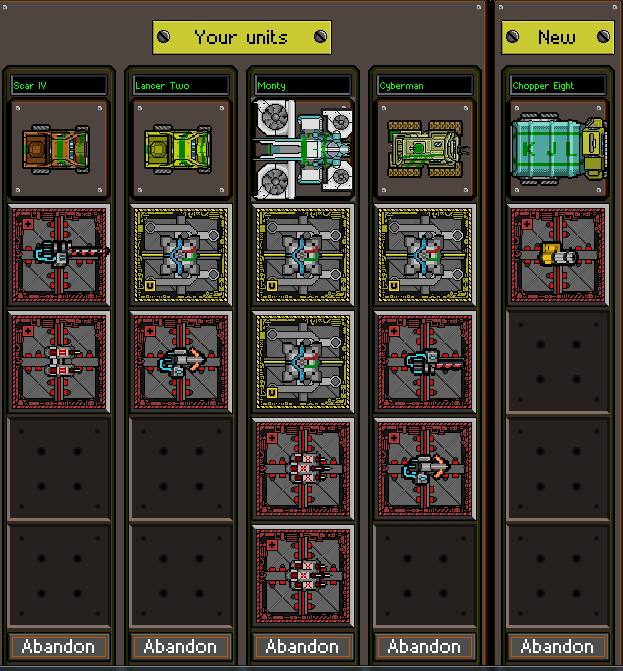
Speaking of mines, these can either be laid down by vehicles, or appear as incoming hazards in combat encounters which occur amidst minefields. Mines do not destroy vehicles outright, but they do inflict considerable damage. Mines can also affect hovercraft.
It is notable that enemies will actively avoid mines and wreckages whenever they can. If the player’s MCV is using a mine-layer, it can be used to force enemies to displace themselves. Yet, this is perhaps of limited use, because they can swerve over to one of two lanes, thus making them less predictable.
FATAL COLLISION HAZARDS:
The player’s convoy will always keep moving, no matter what. Therefore, just about any obstacle which appears in the screen will be a nasty collision hazard. This can be a large rock, a small hill, a building or any other substantial edifice (natural or otherwise), depending on the terrain on which the battle is occurring.
Whatever it is though, if a vehicle runs into it, the vehicle is immediately destroyed. Fortunately, the player is warned of any oncoming obstacles via skull-shaped symbols which appear on the right edge of the screen. The player can then re-position vehicles or prepare to ram enemy vehicles such that their path crosses that of the obstacles and it would be too late for them to take evasive action.
UNLOCKABLE VEHICLES:
Like Faster than Light and other rogue-lite titles, there are alternative options for the player’s starting assets in Convoy. These assets are the pair of escort vehicles and the model of the MCV which the player selects before the start of a playthrough.
The MCVs are actually merely statistically different, but they do have different starting loadouts of equipment. Some appear to be only there to make the obtaining of certain achievements possible. For one, the default MCV can only carry two ship parts at a time, so it cannot be used to obtain the achievement of ferrying all four to the ship at once; that can, however, be done by another MCV model.
Unfortunately, many of unlockable vehicles can only be obtained through sheer luck. To elaborate, the player will need to have the luck to come across the scenarios which are associated with them. Even then, the player might need to have even more luck to have the outcome which unlocks them via these scenarios.
For example, there is a starting pair of escorts which consists of two Keeper Drones. This pair can only be unlocked by defeating “Andy”. “Andy” is an adversary that only appears if the playthrough requires the Hyperdrive Stabilizer as one of the ship parts which the player has to retrieve.
OTHER REPLAYABILITY-RELATED DESIGNS:
Features such as randomization of scenarios, scenario locations and camp locations have been mentioned earlier. These only make any subsequent playthrough a bit different from the earlier ones, but there are other features which contribute to replayability in more significant ways. Of course, these are luck-dependent too, so the diversity of the player’s experience is still a matter of luck.
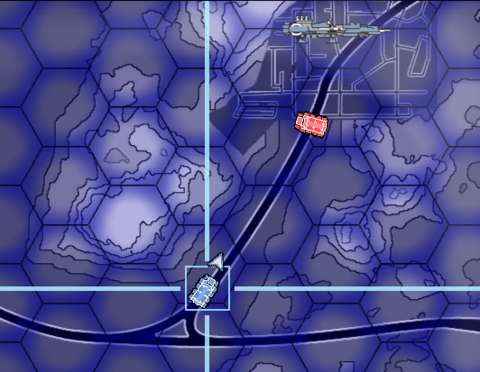
As mentioned earlier, the player’s goal in any playthrough is to obtain parts for the ship. In any playthrough, there are generally four parts to collect.
However, these four are drawn from a larger range of parts. Each part has its own quest-line. Since these quests are also associated with certain special encounters, the player may be fighting different bosses from playthrough to playthrough.
ACHIEVEMENT DATA LOSS & SOLUTION:
Unfortunately, the game has some glitches which hurt its replayability. Chief of these is the loss of data on achievements which have been gained. (Of course, this bug may have been fixed when you, the reader, are reading this. By the way, this happened in the GOG version of the game.)
When the player exits the game entirely and relaunches its program application, some of the player’s accrued data will be reset. This includes any achievements which have been obtained.
To solve this for the Windows & GOG version of the game, the player will need to locate the file which stores the aforementioned data in the Windows user profile documentation, and then make a copy of this. The copy will have to be placed in the installation directory of the game. (The Reddit thread on this technical issue can be found here.)
It is a solution that would have been needless if the developer had discovered this bug, but it has not. The player will have to do this if he/she wants to unlock content, because the achievements are needed for exactly this.
KEEPER DRONES & UNLOCKABLE STARTING PAIR:
The escort vehicle with the best performance in the game is the Keeper Drone and its unique variants. It is one of the most maneuverable vehicles in the game and it has the maximum number of equipment slots. In addition, it is a heavy vehicle.
These advantages obviously make the Keeper Drone one of the most powerful vehicles in the game; even if the player cannot obtain potent weapons for it, its mobility grants it considerable tactical value.
Of course, high-performance hardware and other assets are nothing new in combat-oriented games. Unfortunately, what makes the Keeper Drone noteworthy is that there is an unlockable pair of Keeper Drones which the player can choose as the starting pair of escort vehicles.
It would not have been an issue if this unlockable pair is a reward for players who have spent a lot of time on the game. Yet, it is not such a reward; rather, it is a luck-dependent one. The player will need to have the Hyperdrive Stabilizer as one of the parts which the player has to get for the ship; this in itself is a matter of luck. Then, the player will need to perform the quest which is associated with this part and obtain the opportunity for a combat encounter with a certain character by the name of “Andy”.
This can mean that a player might be able to unlock the pair of Keeper drones within the first few playthroughs, which in turn makes the later playthroughs a lot easier because the player can start with these high-quality vehicles.
ENEMIES:
Most combat encounters will pit the player against enemy vehicles who enter the screen from beyond the edges of the screen.
These enemies will then pick their targets (usually the MCV) and move into position in order to shoot at the latter. The player can attempt to foil their targeting by interposing the player’s own escort vehicles in their way, after which they might shoot at the escort vehicles instead. However, the player’s best bet is still to concentrate fire on individual targets in order to remove them from the battle as soon as possible, thus minimizing the damage that could be inflicted on the convoy.
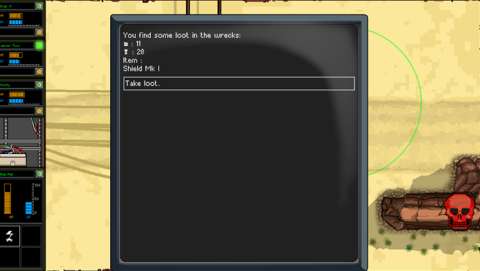
Among the player’s vehicles, only the MCV can use drones, missiles and EMP attacks. However, there are enemy vehicles which can use these even though they are not MCVs.
These enemies usually appear in scenario-triggered combat encounters, rather than the random ones. In particular, the player is likely to face them during the quests to retrieve the ship parts.
BOSSES:
Some scenario-triggered combat encounters pit the player’s convoy against another MCV and its attendants. These enemies are very rare, and they also happen to provide some of the most interesting battles in the game.
In these combat encounters, the player’s MCV is located on the left edge of the screen, whereas the enemy’s is located on the right edge. To end the battle in the player’s favor, the enemy MCV has to be destroyed. This is easier said than done, because the enemy MCV is often well armed and armored. Moreover, it can call in replacement escorts every once in a while, meaning that the enemy has an advantage in a battle of attrition, which the player will want to avoid.
Finally, close to the very end of a near-successful playthrough, the player will have to fight a powerful boss with multiple forms. A well-equipped and upgraded convoy is essential to overcome this enemy, so this combat encounter will be the one which decides how well the player has been doing throughout the playthrough.
VISUAL DESIGNS:
Convoy is a game which makes use of retro-style artwork and graphics for its visual designs. Many things will appear pixelated, but recognizable enough to be distinct from each other.
The most interesting visual design is perhaps the illusion that vehicles are always moving during combat scenarios. The wheels and tracks of every vehicle are always in motion, keeping in line with the intended impression that every vehicle is moving almost as fast as the MCV, which is generally the only vehicle that will not budge from its relative position in the screen.
If the player turns on the associated visual effect options, wheeled and tracked vehicles leave behind tracks which, in the case of enemy vehicles, may help the player figure out their intention. For example, an enemy vehicle that is leaving behind a straight track is likely attempting to overtake the convoy so as to attack it from the front, which in turn suggests that it might have mine-laying equipment.
Unfortunately, some of the game’s most frustrating problems lie in its visual designs.
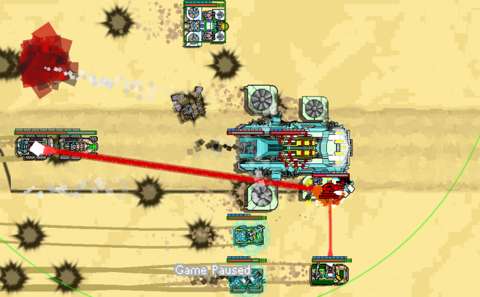
DAMAGE NUMBERS POP-UPS:
To help the player keep track of the amount of damage that he/she is inflicting on enemy vehicles, the game will display text which pops up from vehicles when they are damaged.
Such visual designs are nothing new and would not have been noteworthy in this review, but unfortunately, they are because of a glitch. This glitch affects the first time that a damage number pops up after the game application has been launched; the game will freeze for a few seconds, presumably to load the fonts for the text and other things into memory. The game will eventually un-freeze, but this bug is still quite annoying.
ABSENCE OF TOGGLE FOR HITPOINT AND ARMOR METERS/COUNTERS:
During combat, the player is shown the HP and armor meters for every vehicle, so the player will know how close to destruction each vehicle is. However, these meters are percentage-based, so the player will not immediately know exactly how much damage that a vehicle can take before blowing up.
Knowing this would have been very helpful in avoiding over-kills and deciding when to re-assign targets for vehicles under the player’s control. An option to switch the meters over to digit-based counters would have been much welcome, but this option is not there (at least not in the build of the game that was played for the purpose of this review).
Incidentally, the digit-based counters are available when the player is making use of camps to repair the convoy’s vehicles. This is fortunate, yet considering that such counters are in the game, that they have not been implemented for the purpose of managing combat is a glaring gap in game design.
SOUND DESIGNS:
There are only a few musical soundtracks in the game. Still, they are quite pleasant to the ears and would not become tiresome too quickly. For example, there is a melancholic but otherwise serene track for when the player’s convoy is not engaged in battle. This track almost seamlessly switches to a more exciting one when combat encounters do encounter. There is also a track for special combat encounters, the tempo of which is appropriately greater.
Most of the voice-overs which can be heard in the game have radio-like qualities to them, which is perhaps appropriate considering that the operators of the convoy’s vehicles would have no other practical way to communicate. Speaking of which, the voice-overs for the operators would sound a bit familiar to players who have played video games during the 1990s. For example, some of them sound like the responses of units in the original Command & Conquer.
For a game which has a lot of combat in it, it is fortunate that Convoy’s developers have invested some effort into making sure that the sound effects do not sound retro. Most weapons-fire sounds appropriately impactful and distinct enough from each other. Explosions are satisfyingly loud, especially so because vehicles on the verge of destruction do not immediately blow up but are wrecked by a series of blasts.
More importantly, these are the sounds which the player will hear quite often if the player’s battle plans and decisions had been very effective.
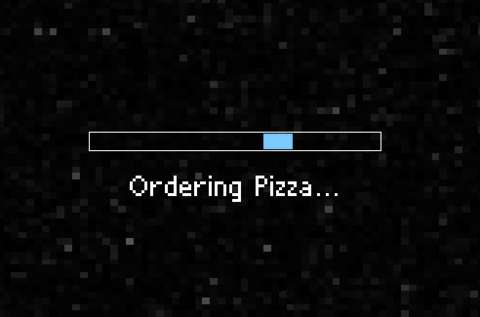
MANY REFERENCES:
Convoy will drop a lot of references to popular cultures, particular individuals and other games. Some of them are overt, such as mentions of the late Terry Pratchett. Some are roundabout, such as the description of certain characters and an artifact which were particularly prominent in Dungeon of the Endless, which is another indie game.
These references can be plentiful to the point of being irritating in the non-combat segments of Convoy. Fortunately, there are none to be had during the combat encounters.
SUMMARY:
At first glance, Convoy appears to have the same issue as so many other indie rogue-lites, which is the preponderance of luck in the gameplay. There are many random encounters to be had, and the outcomes of many scenarios are decided on the roll of RNGs.
Fortunately, luck is removed as a factor at where the gameplay is at its most significant. Combat is a matter of planning and execution, both of which are within the control of the player and not fickle RNGs.
Yet, although the luck-dependent gameplay elements of Convoy is compensated by the skill-rewarding ones, there are still problems which detract from the overall experience. Chief of these are the lack of user-friendly features, such as an option to toggle hit-point displays between meters and numbers and an option to see the map of Omek Prime in its entirety. There are also glitches which injure the replayability of the game, namely bugs which affect achievements, which in turn affect the unlocking of content.

